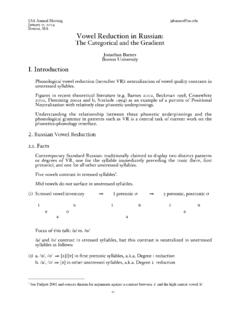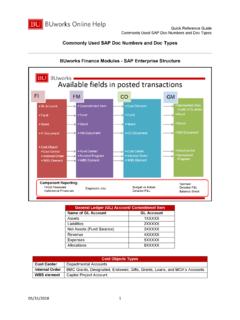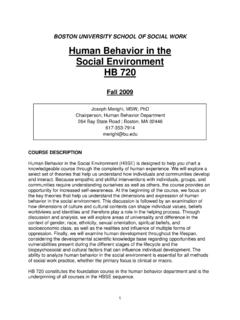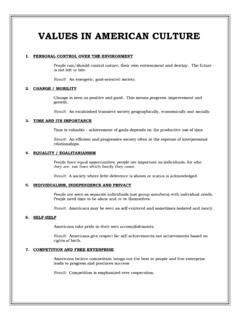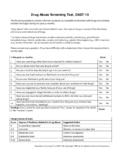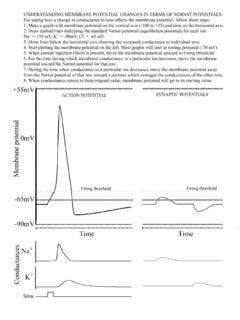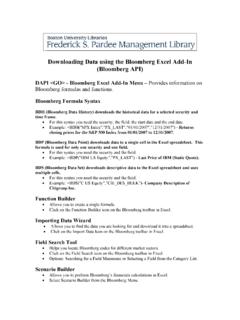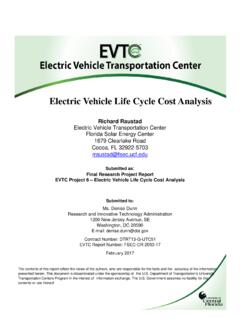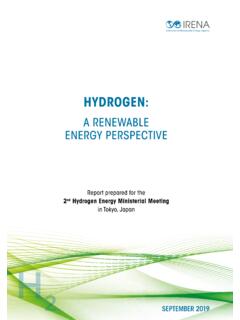Transcription of The Economics of Renewable Energy
1 The Economics ofRenewable Energyby David Timmons, Jonathan M. Harris, and Brian Roach Global Development And Environment Institute Tufts University Medford, MA 02155 A GDAE Teaching Module on Social and Environmental Issues in Economics 1 Copyright 2014 Global Development And Environment Institute, Tufts University. Copyright release is hereby granted for instructors to copy this module for instructional purposes. Students may also download the module directly from Comments and feedback from course use are welcomed: Global Development And Environment Institute Tufts University Medford, MA 02155 E-mail: David Timmons is Assistant Professor of Environmental Economics at the University of Massachusetts, Boston, Massachusetts.
2 Jonathan M. Harris and Brian Roach are Senior Research Associates at the Tufts University Global Development and Environment Institute, Medford, Massachusetts. 2 Table of Contents 1. Energy TRANSITIONS .. 3 2. Renewable Energy SOURCES .. 5 Biomass .. 5 Hydropower .. 7 Wind power .. 10 Direct solar Energy .. 12 Geothermal Energy .. 14 Renewable Energy Availability .. 15 3. Renewable Energy Economics .. 17 Net Energy .. 19 Intermittency .. 20 Capital Intensity .. 22 Renewable Energy Mix and Energy Conservation .. 23 The Potential for Energy Efficiency .. 24 Energy Subsidies .. 27 Environmental Externalities .. 29 4. THE Renewable Energy TRANSITION.
3 31 Rising Fossil Fuel Costs .. 31 Declining Renewable Energy Costs .. 32 Accounting for Fossil Fuel Externalities .. 35 Policies for the Renewable Energy Transition .. 35 SUMMARY .. 41 DISCUSSION QUESTIONS .. 42 EXERCISES .. 43 REFERENCES .. 45 ADDITIONAL RESOURCES .. 48 GLOSSARY .. 49 3 THE Economics OF Renewable Energy 1. Energy TRANSITIONS The history of industrial civilization is a history of Energy transitions. In less developed, agrarian economies, people's basic need for food calories is provided through simple forms of agriculture, which is essentially a method of capturing solar Energy for human use. solar Energy stored in firewood or other biomass Energy meets other basic needs for home heating and cooking.
4 As economies develop and become more complex, Energy needs increase greatly. Historically, as supplies of firewood and other biomass Energy proved insufficient to support growing economies in Europe and the United States, people turned to hydropower (also a form of stored solar Energy ), then to coal during the nineteenth century, and then to oil and natural gas during the twentieth century. In the 1950s nuclear power was introduced into the Energy mix. Each stage of economic development has been accompanied by a characteristic Energy transition from one major fuel source to another. Today, fossil fuels coal, oil and natural gas are by far the dominant Energy source in industrial economies, and the main source of Energy production growth in developing economies (see Figure 1).
5 But the twenty-first century is already seeing the start of the next great transition in Energy sources away from fossil fuels towards Renewable Energy sources. This transition is motivated by many factors, including concerns about environmental impacts (particularly climate change), limits on fossil fuel supplies, prices, and technological change. Society will eventually adopt Renewable Energy , since fossil fuels are limited in supply and only created over geologic time. Thus the question is not whether society will shift to Renewable Energy , but when. Fossil fuel reserve lifetimes may be extended by new technologies for extraction, but the need to minimize the damaging effects of climate change is a more immediate problem than fossil fuel depletion.
6 If the worst impacts of rising temperatures and climate alteration are to be avoided, society needs to switch to Renewable Energy sources while much fossil carbon is still safely buried in the earth s crust. This module focuses on the outlines of the new Renewable Energy economy that must eventually take hold: what Renewable Energy sources are available, and how will optimum mixtures of Renewable - Energy sources be determined? How will Renewable - Energy mixtures vary by location? What are the direct and external costs of the new Renewable Energy sources likely to be? How will Renewable - Energy realities change the way Energy is used in the economy?
7 What kind of engineering, economic, and policy adjustments will be needed to accommodate Renewable Energy sources, which are somewhat different from fossil fuels? 4 Because so much of the capital stock and infrastructure of modern economic systems are based on fossil-fuel Energy use, any transition away from fossil-fuel dependence will involve massive restructuring and new investment. While private markets will play a critical role in this process, major changes in government policies are necessary to foster the transition. The considerable economic implications of this justify a special focus on Renewable Energy use as a central economic and environmental issue.
8 Figure 1. Global Energy Consumption by Source, 2011 Source: International Energy Agency (IEA 2013) Oil Coal Natural Gas Nuclear Hydropower Biomass Wind, solar , geothermal 5 2. Renewable Energy SOURCES In one sense, Renewable Energy is unlimited, as supplies are continually replenished through natural processes. The daily supply of solar Energy is theoretically sufficient to meet all human Energy needs for an entire year. But solar Energy and other Renewable Energy sources are limited in the sense that their availability varies across space and time. Some regions of the world are particularly well-suited for wind and/or solar Energy .
9 For example, solar Energy potential is highest in the Southwestern United States, Northern Africa and the Middle East, and parts of Australia and South America. Some of the best regions for wind Energy include Northern Europe, the southern tip of South America, and the Great Lakes region of the United States. Geothermal Energy is abundant in countries such as Iceland and the Philippines. Every world region has some Renewable Energy resources, though availability and cost of using these vary. Most Renewable Energy is ultimately solar Energy . The sun s Energy can be used directly for heat or electricity. Hydropower comes from falling water, which occurs because solar Energy evaporates water at low elevations that later rains on high elevations.
10 The sun also creates wind through differential heating of the earth s surface. Biomass Energy comes from plant matter, produced in photosynthesis driven by the sun. Thus biomass, wind, and hydropower are just secondary sources of solar Energy . Non- solar Renewable Energy sources include geothermal Energy , which comes from the earth s core, in some combination of Energy left from the origin and continued decay of nuclear materials. Tidal Energy is another non- solar Renewable Energy source, being driven by the moon. Though nuclear power from fission is not Renewable , there is great debate about whether nuclear power should be part of the post-fossil-fuel Energy mix (see Box 1).

